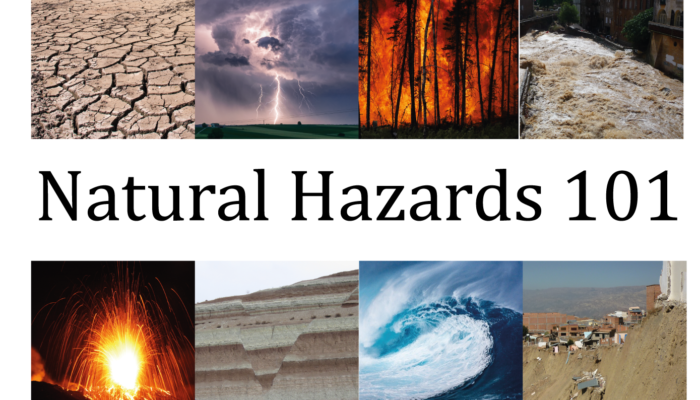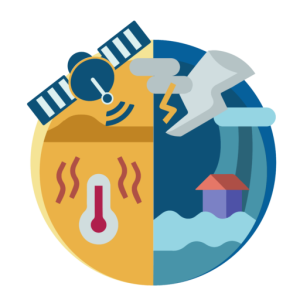By Silvia De Angeli, posted on the blog of the Natural Hazards (NH) Division of the European Geosciences Union (EGU)Read the original article here

Photo credit, from top left to bottom right: Pamela Trisolino (via Imaggeo), Michiel Baatsen (via Imaggeo), Stefan Doerr (via Imaggeo), Dimitri Defrance (via Imaggeo), Katja Bigge (via Imaggeo), Babak Hejrani (via Imaggeo), Elias Sch (via Pixabay) and Dan Killam (via Imaggeo).
With the Natural Hazards 101 series, we mean to bring our readers closer to the terminology often used in the field of natural hazards, but that may not be so familiar.
In the first episode of the series, we focused on the definition of hazard and natural hazard. We moved then to the concepts of risk, disaster risk management, and the forecasting and modelling of natural hazards. In this episode, we will explore the meaning of multi-hazards and multi-hazard risk.
According to UNDRR [1], the multi-hazard concept refers to “(1) the selection of multiple major hazards that the country faces, and (2) the specific contexts where hazardous events may occur simultaneously, cascadingly or cumulatively over time, and taking into account the potential interrelated effects.”
These definitions of multi-hazard represent two major categories in which multi-hazard approaches can be classified: (i) independent multi-hazards approaches, where single hazards are just overlayed and treated as independent phenomena, and (ii) approaches that consider multiple hazards and their potential interactions.
Single hazard and independent multi-hazards approaches could potentially underestimate the risk leading to inadequate disaster risk reduction measures. Although more challenging and demanding, the approaches that consider multiple hazards and their potential interactions are better able to capture the real risk in many areas of the world.
The interactions between hazards are diverse and complicated, which leads to differences in the literature regarding the identification and classification of these interactions (see for example, [2, 3,4]). However, it is possible to identify some basic mechanisms of interaction:
- Triggering is when one hazard directly triggers another, generating what is called a “domino effect” or “triggering mechanism” among hazards. This is the case of the Great East Japan Earthquake that struck in the Pacific Ocean off the northeast coast of Japan’s Honshu island in 2011 and triggered a massive tsunami that flooded more than 200 square miles of coastal land [5].
- Influence is when one hazard can influence another hazard, for example, changing its probability of occurrence or magnitude, without acting as a trigger. A typical example is the removal of protective forest by an avalanche in winter that leads to higher frequency and magnitude of rock falls during summer [6].
- Coincidence is when hazards occur in the same place simultaneously independently from the causal dependence among them. For example, the volcanic eruption of Mount Pinatubo in the Philippines in 1991 coincided with the intense rainfalls caused by the passage of Typhoon Yunya [2].
In contrast to single hazard events, the assessment of multiple hazards and their relationships poses a series of challenges in each step of the risk analysis: from the assessment of the hazard level to the vulnerability analysis and the resultant risk level. Indeed, hazard dependencies may influence the overall hazard level and the vulnerability of elements at risk.
As an emerging focus of research and interest, the multi-hazard risk still lacks a common and standard definition and glossary among the different communities [7]. Some authors distinguish between ‘multi-hazard risk’ and ‘multi-risk’. Kappes et al. [6] define multi-hazard risk as a risk evaluation that considers the impact of multiple hazards, and multi-risk as related to the assessment of multiple risks such as economic, ecological, social, etc. Other authors [8, 9] use the term multi-risk to define an approach that determines the whole risk from several hazards, accounting for possible hazards and vulnerability interactions entailing both a multi-hazard and multi-vulnerability perspective.
The concept of multi-vulnerability refers to “the ensemble of interconnected and dynamic vulnerabilities among different exposed elements” [9]. For physical vulnerability assessments, multi-vulnerability mainly refers to the development of multi-hazard damage or fragility functions (for example, [10]), able to model the damage caused by simultaneous or subsequent hazards on the same exposed element.
Multi-hazard risk (or multi-risk) approaches are crucial to define successful disaster risk reduction measures. Traditionally, disaster risk reduction measures are implemented to decrease the risk of a single hazard type despite their potential of having unwanted effects on other hazard typologies. These potentially negative effects between measures are defined by de Ruiter et al. [11] as ‘asynergies’. For example, building on stilts is an often-used measure to decrease a building’s flood vulnerability; however, it simultaneously increases its earthquake vulnerability [11]. Multi-hazard risk approaches allow improving the understanding of these asynergies, identifying measures able to successfully reduce the impacts of disasters across different hazards.
Please consider that this post does not aim to provide an exhaustive literature review on multi-hazard risk but only provides examples to support the presented concepts and definitions.
Read episode 1: What is a -natural- hazard?
Read episode 2: The concept of risk.
Read episode 3: The disaster cycle.
Read episode 4: Forecasting and modelling.
References
[1] https://www.undrr.org/terminology#R
[2] Gill, J. C., & Malamud, B. D. (2014). Reviewing and visualizing the interactions of natural hazards. Reviews of Geophysics, 52(4), 680-722. https://doi.org/10.1002/2013RG000445
[3] Liu, B., Siu, Y. L., & Mitchell, G. (2016). Hazard interaction analysis for multi-hazard risk assessment: a systematic classification based on hazard-forming environment. Natural Hazards and Earth System Sciences, 16(2), 629-642. https://doi.org/10.5194/nhess-16-629-2016
[4] Tilloy, A., Malamud, B. D., Winter, H., & Joly-Laugel, A. (2019). A review of quantification methodologies for multi-hazard interrelationships. Earth-Science Reviews, 196, 102881. https://doi.org/10.1016/j.earscirev.2019.102881
[5] Mimura, N., Yasuhara, K., Kawagoe, S., Yokoki, H., & Kazama, S. (2011). Damage from the Great East Japan Earthquake and Tsunami-a quick report. Mitigation and adaptation strategies for global change, 16(7), 803-818. https://doi.org/10.1007/s11027-011-9297-7
[6] Kappes, M. S., Keiler, M., von Elverfeldt, K., & Glade, T. (2012). Challenges of analyzing multi-hazard risk: a review. Natural hazards, 64(2), 1925-1958. https://doi.org/10.1007/s11069-012-0294-2
[7] Gallina, V., Torresan, S., Critto, A., Sperotto, A., Glade, T., & Marcomini, A. (2016). A review of multi-risk methodologies for natural hazards: Consequences and challenges for a climate change impact assessment. Journal of environmental management, 168, 123-132. https://doi.org/10.1016/j.jenvman.2015.11.011
[8] Carpignano, A., Golia, E., Di Mauro, C., Bouchon, S., & Nordvik, J. P. (2009). A methodological approach for the definition of multi‐risk maps at regional level: first application. Journal of risk research, 12(3-4), 513-534. https://doi.org/10.1080/13669870903050269
[9] Terzi, S., Torresan, S., Schneiderbauer, S., Critto, A., Zebisch, M., & Marcomini, A. (2019). Multi-risk assessment in mountain regions: A review of modelling approaches for climate change adaptation. Journal of environmental management, 232, 759-771. https://doi.org/10.1016/j.jenvman.2018.11.100
[10] Luo, H., Zhang, L., Wang, H., & He, J. (2020). Multi-hazard vulnerability of buildings to debris flows. Engineering Geology, 279, 105859. https://doi.org/10.1016/j.enggeo.2020.105859
[11] de Ruiter, M. C., De Bruijn, J. A., Englhardt, J., Daniell, J. E., de Moel, H., & Ward, P. J. (2021). The asynergies of structural disaster risk reduction measures: Comparing floods and earthquakes. Earth’s Future, 9(1), e2020EF001531. https://doi.org/10.1029/2020EF001531
Post edited by Giulia Roder, Valeria Cigala.
